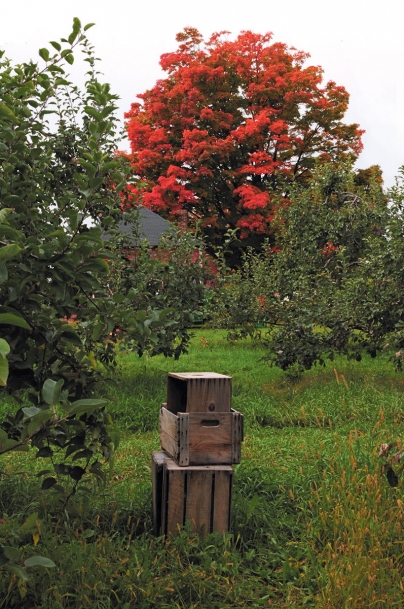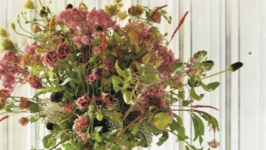Autumn’s Edible Garden
Fall musings of a garden designer
I have to admit it: I have a life-long love affair with Ohio in the fall. Where to start? I love when the summer heat releases its relentless grasp to fall’s crisp, refreshingly cool days with cloudless skies. Parched lawns carpet themselves in a lush emerald green hue last seen in May. Ohio forests and urban trees begin their magical transformation to a kaleidoscope of blazing tints of crimson, gold and orange. And oh, the anticipation of savoring the rich spectrum of flavors available in our autumn food palette.
The cooler days of autumn also offer a great opportunity for evaluating the overall structure of the edible garden. I like taking advantage of sales at the local nurseries by evaluating bare areas in the garden that could benefit from additional edible planting. A long, narrow bed along the gravel path in my formal herb garden would lend itself well to a neat border of raspberry shortcake. These dwarf thornless raspberry bushes are self-fertile, and they mature to a compact size of only three feet wide by three feet tall. Their petite, rounded habit does not require staking or trellising; a light pruning of dead canes next spring will encourage prolific fruiting next summer. An extra bonus: many raspberry shortcake plants boast an attractive reddish-gold fall foliage color.
A huge vintage concrete urn at the base of some rustic stone steps is beautiful empty, but I’m considering planting it with a carmine jewel dwarf cherry bush this fall. This medium-sized shrub with glossy, green leaves reaches 6 inches high at maturity and is covered with pink and white blossoms in the spring. The attractive flowers are followed by large, wine-colored cherries in late summer to early fall. The fruit’s intriguing sweet-tart flavor allows it to be used for pies, tarts and out-of-hand eating. It’s cold-hardy and self-pollinating, so I’ll get loads of fruit quickly from just one plant. Carmine jewel has shown exceptional resistance to disease and insect damage, making it a great choice for gardeners who prefer to follow more organic maintenance practices.
I’ve been keeping an eye out for a good place to plant some of Brazelberries’ compact blueberry bush called blueberry glaze. A generously proportioned cedar packing crate from the 1920s that I recently picked up for a song might be a good candidate. It’s deep, square profile should support four of the petite, boxwood-like blueberry plants. Blueberry glaze has showy white spring flowers set off by fine-textured glossy green foliage that turns burgundy in the fall. Clusters of small, intensely sweet deep-blue berries appear in mid-summer.
All blueberries prefer soil that is more acidic than Columbus’s very alkaline soil, so I’ll need to adjust the soil in the planter box more to their liking. I’ll incorporate some peat moss into the soil mix at the time of planting, and will scratch some more into the soil once a year. I’ll also apply Espoma’s excellent organic soil acidifier around the base of each plant each spring to continue to help to adjust the pH balance of the soil.
Another enjoyable activity for those brilliant fall days is collecting seeds for the next growing year. Collecting and saving seeds is an ancient practice that ensures that I’ll be able to plant my favorite crops next year. My small-scale collecting is primarily a personal celebration of an ancient fall ritual, but on a larger scale, saving seeds is a powerful strategy to preserve heirloom plant varieties and avoid genetic modification. After I’ve collected my seeds, I remove any lingering stems, pods, petals and foliage and spread the seeds out on an old screen in my garage. When they’re dry, I store them in labeled paper envelopes at room temperature.
I particularly love collecting scarlet runner bean seeds. Painted Lady, a variety documented as far back as 1596, has namesake flowers of red and white acknowledging Queen Elizabeth I’s penchant for rouge and face powder. Beloved by bees and hummingbirds, the foliage quickly covers iron tuteurs or bamboo teepees to create striking vertical elements in the garden. I usually steam or sauté the pods at the “snap” stage, but I allow a few to dry on the plants until the pods rattle for use in soups or for saving for the following year. The huge, black-and-pink seeds look glorious in a small silver bowl on the painted sideboard in my dining room.
I usually do some harvesting in the fall from the wilder corners of my yard for medicinal and edible use over the winter. Spicebush, whose scientific name is Lindera benzoin, is an aromatic shrub native to Central Ohio’s moist forest understory. Very early yellow spring flowers, golden fall color and medium stature make spicebush a great choice for urban landscapes. The small, bright red oval fruits appear late in the summer and in early fall. I’ve found that their warm, spicy, peppery taste partners well with venison and pork dishes. You’ll want to keep both fresh and dried berries in the refrigerator, as their high oil content can turn them rancid at room temperature. Fresh or dried leaves and twigs can be steeped in boiling water to produce a tea that is spicy with light citrus notes.
A mature eastern white pine, Pinus strobus, straddles the property line in my back yard. I collect its long, dark green needles repeatedly over the course of fall and winter to brew into a pungent, strongly flavored tea that is good sweetened with raw honey. The needles have extremely high levels of vitamin C and contain traces of the antibacterial sap. White pine tea was used by Iroquois tribes to treat bronchitis and sinusitis.
As I finally stretch white row covers over my raised beds around Thanksgiving, I’m fully in the process of moving into the quieter, deeper, more introspective season of late fall and early winter. Both the edible garden and I will spend much of the coming months under cozier, warmer cover. I’ll continue to reach under the garden’s row covers to collect small harvests of kale, lettuce, sorrel, rosemary, thyme and mint, and will enjoy combining them with dried herbs and fall root crops and meats to create comforting, savory dishes.
See you in the spring!







